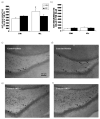Endogenous cannabinoid signaling is required for voluntary exercise-induced enhancement of progenitor cell proliferation in the hippocampus
- PMID: 19489006
- PMCID: PMC2847038
- DOI: 10.1002/hipo.20647
Endogenous cannabinoid signaling is required for voluntary exercise-induced enhancement of progenitor cell proliferation in the hippocampus
Abstract
Voluntary exercise and endogenous cannabinoid activity have independently been shown to regulate hippocampal plasticity. The aim of the current study was to determine whether the endocannabinoid system is regulated by voluntary exercise and if these changes contribute to exercise-induced enhancement of cell proliferation. In Experiment 1, 8 days of free access to a running wheel increased the agonist binding site density of the cannabinoid CB(1) receptor; CB(1) receptor-mediated GTPgammaS binding; and the tissue content of the endocannabinoid anandamide in the hippocampus but not in the prefrontal cortex. In Experiment 2, the CB(1) receptor antagonist AM251 (1 mg kg(-1)) was administered daily to animals given free access to a running wheel for 8 days, after which cell proliferation in the hippocampus was examined through immunohistochemical analysis of the cell cycle protein Ki-67. Voluntary exercise increased proliferation of progenitor cells, as evidenced by the increase in the number of Ki-67 positive cells in the granule cell layer of the dentate gyrus (DG) in the hippocampus. However, this effect was abrogated by concurrent treatment with AM251, indicating that the increase in endocannabinoid signaling in the hippocampus is required for the exercise-induced increase in cell proliferation. These data demonstrate that the endocannabinoid system in the hippocampus is sensitive to environmental change and suggest that it is a mediator of experience-induced plasticity.
(c) 2009 Wiley-Liss, Inc.
Figures



Similar articles
-
A role for the endocannabinoid system in exercise-induced spatial memory enhancement in mice.Hippocampus. 2014 Jan;24(1):79-88. doi: 10.1002/hipo.22206. Epub 2013 Oct 18. Hippocampus. 2014. PMID: 24115292
-
Electroconvulsive shock treatment differentially modulates cortical and subcortical endocannabinoid activity.J Neurochem. 2007 Oct;103(1):47-56. doi: 10.1111/j.1471-4159.2007.04688.x. Epub 2007 Jun 11. J Neurochem. 2007. PMID: 17561935
-
Local enhancement of cannabinoid CB1 receptor signalling in the dorsal hippocampus elicits an antidepressant-like effect.Behav Pharmacol. 2007 Sep;18(5-6):431-8. doi: 10.1097/FBP.0b013e3282ee7b44. Behav Pharmacol. 2007. PMID: 17762511
-
Enhancement of endocannabinoid signaling and the pharmacotherapy of depression.Pharmacol Res. 2007 Nov;56(5):360-6. doi: 10.1016/j.phrs.2007.09.003. Epub 2007 Sep 11. Pharmacol Res. 2007. PMID: 17945507 Free PMC article. Review.
-
Sexually-dimorphic alterations in cannabinoid receptor density depend upon prenatal/early postnatal history.Neurotoxicol Teratol. 2016 Nov-Dec;58:31-39. doi: 10.1016/j.ntt.2016.09.004. Epub 2016 Sep 12. Neurotoxicol Teratol. 2016. PMID: 27634313 Free PMC article. Review.
Cited by
-
The Endocannabinoid System and Physical Activity-A Robust Duo in the Novel Therapeutic Approach against Metabolic Disorders.Int J Mol Sci. 2022 Mar 12;23(6):3083. doi: 10.3390/ijms23063083. Int J Mol Sci. 2022. PMID: 35328503 Free PMC article. Review.
-
The biological control of voluntary exercise, spontaneous physical activity and daily energy expenditure in relation to obesity: human and rodent perspectives.J Exp Biol. 2011 Jan 15;214(Pt 2):206-29. doi: 10.1242/jeb.048397. J Exp Biol. 2011. PMID: 21177942 Free PMC article. Review.
-
Circulating levels of endocannabinoids respond acutely to voluntary exercise, are altered in mice selectively bred for high voluntary wheel running, and differ between the sexes.Physiol Behav. 2017 Mar 1;170:141-150. doi: 10.1016/j.physbeh.2016.11.041. Epub 2016 Dec 22. Physiol Behav. 2017. PMID: 28017680 Free PMC article.
-
A single session of moderate intensity exercise influences memory, endocannabinoids and brain derived neurotrophic factor levels in men.Sci Rep. 2021 Jul 13;11(1):14371. doi: 10.1038/s41598-021-93813-5. Sci Rep. 2021. PMID: 34257382 Free PMC article.
-
Physical exercise, neuroplasticity, spatial learning and memory.Cell Mol Life Sci. 2016 Mar;73(5):975-83. doi: 10.1007/s00018-015-2102-0. Epub 2015 Dec 8. Cell Mol Life Sci. 2016. PMID: 26646070 Free PMC article. Review.
References
-
- Aberg ND, Johansson UE, Aberg MA, Hellstrom NA, Lind J, Bull C, Isgaard J, Anderson MF, Oscarsson J, Eriksson PS. IGF-I has a direct proliferative effect in adult hippocampal progenitor cells. Mol Cell Neurosci. 2003;24:23–30. - PubMed
-
- Aguado T, Monory K, Palazuelos J, Stella N, Cravatt B, Lutz B, Marsicano G, Kokaia Z, Guzman M, Galve-Roperh I. The endocannabinoid system drives neural progenitor proliferation. FASEB J. 2005;19:1704–1706. - PubMed
-
- Aso E, Ozaita A, Valdizan EM, Ledent C, Pazos A, Maldonado R, Valverde O. BDNF impairment in the hippocampus is related to enhanced despair behavior in CB(1) knockout mice. J Neurochem. 2008;105:565–572. - PubMed
Publication types
MeSH terms
Substances
Grants and funding
LinkOut - more resources
Full Text Sources

